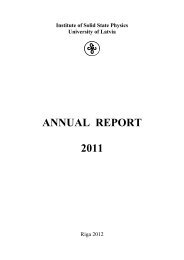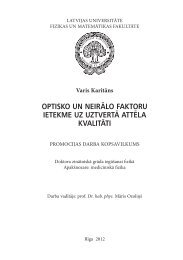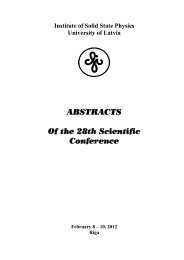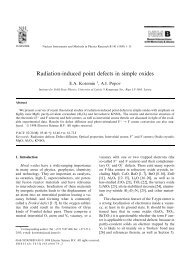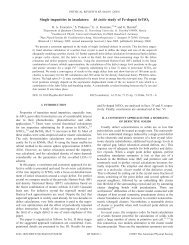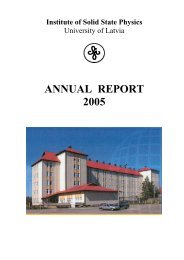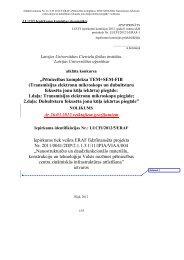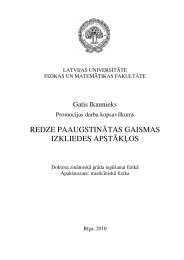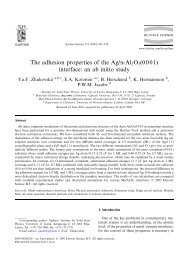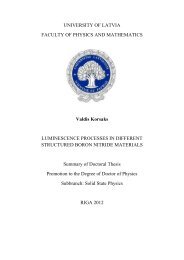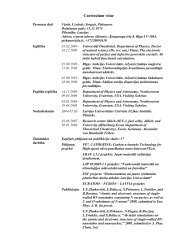Annual Report 2012 - Latvijas Universitātes Cietvielu fizikas institūts
Annual Report 2012 - Latvijas Universitātes Cietvielu fizikas institūts
Annual Report 2012 - Latvijas Universitātes Cietvielu fizikas institūts
You also want an ePaper? Increase the reach of your titles
YUMPU automatically turns print PDFs into web optimized ePapers that Google loves.
REGIONS OF AZIMUTHAL INSTABILITY IN GYROTRONS<br />
O. Dumbrajs,<br />
G. S, Nusinovich, and T. M. Antonsen, Jr.<br />
Institute for Research in Electronics and Applied Physics, University of Maryland, USA<br />
This paper is devoted to the analysis of the instability of operating modes in highpower<br />
gyrotrons with cylindrically symmetric resonators. This instability manifests itself<br />
in destruction of the azimuthally uniform wave envelope rotating in a gyrotron resonator<br />
having a transverse size greatly exceeding the wavelength. The appearance of<br />
azimuthally nonuniform solutions can be interpreted as simultaneous excitation of<br />
modes with different azimuthal indices. This problem is studied self-consistently, i.e.<br />
taking into account the temporal evolution of both the azimuthal and axial structures of<br />
the wave envelope. The region of gyrotron operation free from this instability is<br />
identified. The efficiency achievable in this region can be only 1-2% lower than the<br />
maximum efficiency. It is also possible to address the difference between the theory of<br />
mode interaction developed under assumption that all modes have fixed axial structure<br />
and the self-consistent theory presented here. As known, for fixed axial mode profiles,<br />
single-mode high-efficiency oscillations remain stable no matter how dense is the<br />
spectrum of competing modes, while the self-consistent theory predicts stable highefficiency<br />
operation only when the azimuthal index does not exceed a certain critical<br />
value. It is shown that the azimuthal instability found in the self-consistent theory is<br />
caused by excitation of modes having axial structures different from that of the desired<br />
central mode.<br />
Defence of PhD Theses<br />
The Doctoral Thesis D. Bocharov “First principles simulations on surface properties and<br />
reactivity of sustainable nitride nuclear fuels” was defended in January <strong>2012</strong> at the<br />
University of Latvia.<br />
Scientific Publications<br />
SCI publications<br />
1. P. Savchyn, I. Karbovnyk, V. Vistovskyy, A. Voloshinovskii, V. Pankratov, M.<br />
Cestelli Guidi, C. Mirri, O. Myahkota, A. Riabtseva, N. Mitina, A. Zaichenko, and A.I.<br />
Popov, Vibrational properties of LaPO 4 nanoparticles in mid- and far-infrared domain. -<br />
J. Appl. Phys., <strong>2012</strong>, 112, 124309 (p. 1-6).<br />
2. R.I. Eglitis, Ab initio calculations of the atomic and electronic structure of SrZrO 3<br />
(111) surfaces. - Ferroelectrics, <strong>2012</strong>, 436, p. 5-11.<br />
3. Yu.F. Zhukovskii, S. Piskunov, and S. Bellucci, Double-wall carbon nanotubes of<br />
different morphology: electronic structure simulations. - Nanosci. Nanotechnol. Lett.,<br />
<strong>2012</strong>, 4, p. 1074-1081.<br />
4. P.K. Jha, V.N. Kuzovkov, and M. Olvera de la Cruz, Kinetic Monte Carlo<br />
simulations of flow-assisted polymerization. - ACS Macro Lett., <strong>2012</strong>, 1, p. 1393−1397.<br />
5. O. Dumbrajs, T. Idehara, T. Saito, and Y. Tatematsu, Calculations of starting<br />
currents and frequencies in frequency-tunable gyrotrons. - Jpn. J. Appl. Phys., <strong>2012</strong>, 51,<br />
126601 (p. 1-5).<br />
6. O. Dumbrajs and G.S. Nusinovich, On optimization of sub-THz gyrotron<br />
parameters. - Phys. Plasmas, <strong>2012</strong>, 19, 103112 (p. 1-6).<br />
7. O. Dumbrajs and T. Idehara, Analysis of aftercavity interaction in European ITER<br />
gyrotrons and in the compact Sub-THz gyrotron FU CW-CI. - J. Infrared Milli. Terahz.<br />
Waves, <strong>2012</strong>, 33, p. 1171–1181.<br />
73



